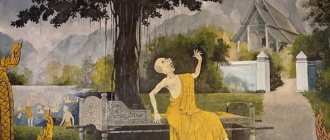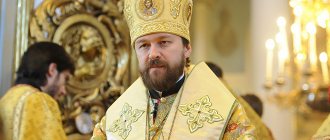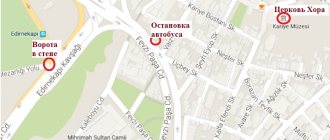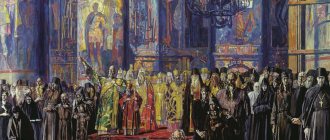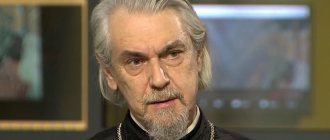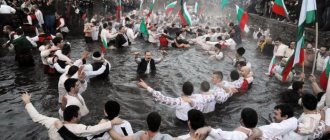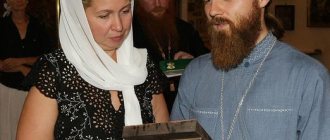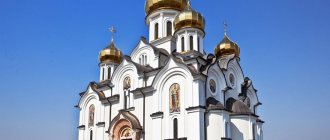In recent years, interest in the Old Believers . Many both secular and ecclesiastical authors publish materials devoted to the spiritual and cultural heritage, history and modern day of the Old Believers. However, the phenomenon of the Old Believers itself, its philosophy, worldview and features of terminology are still poorly studied. about the semantic meaning of the term “ Old Believers ” in the article “ What are Old Believers? "
Dissenters or Old Believers?
Old Believers itself arose forcedly. The fact is that the Synodal Church, its missionaries and theologians called the supporters of pre-schism, pre-Nikon Orthodoxy nothing more than schismatics and heretics. This was done because the ancient Russian Old Believer church traditions, which existed in Rus' for almost 700 years, were recognized as non-Orthodox, schismatic and heretical at the New Believer councils of 1656, 1666–1667.
Sergius of Radonezh In fact, such a great Russian ascetic as Sergius of Radonezh was recognized as non-Orthodox, which caused an obvious deep
protest among believers .
The Synodal Church took this position as the main one and used it, explaining that supporters of all Old Believer agreements without exception fell away from the “true” Church because of their firm reluctance to accept church reform, which Patriarch Nikon and continued to one degree or another his followers, including Emperor Peter I.
On this basis, everyone who did not accept the reforms was called schismatics , shifting onto them the responsibility for the schism of the Russian Church, for the alleged separation from Orthodoxy. Until the beginning of the 20th century, in all polemical literature published by the dominant church, Christians professing pre-schism church traditions were called “schismatics,” and the very spiritual movement of the Russian people in defense of paternal church customs was called “schism.”
This and other even more offensive terms were used not only to expose or humiliate the Old Believers, but also to justify persecution and mass repressions against supporters of ancient Russian church piety. In the book “ Spiritual Sling ,” published with the blessing of the New Believer Synod, it was said:
“The schismatics are not the sons of the church, but sheer heedless ones. They are worthy of being handed over to the punishment of the city court... worthy of all punishment and wounds. And if there is no healing, there will be death .
Confrontation between church traditions
The schism became one of the most expressive phenomena of Russian spiritual life. On the one hand, the Nikonians, adherents of reforms according to the Greek model, sought to introduce fresh thought into liturgical rites and books, and advocates of serious religious education. On the other hand, representatives of the moral forces of the old society, who relied on “Stoglav”, and were ready “for the sake of ancient piety and carelessness,” to endure torment, deprivation and go to death.
The emergence of contradictions
The first significant clash occurred at the Nikonian Council of 1654, which discussed the issue of unifying Russian liturgical literature according to Greek models printed in the West. A dispute broke out between the participants over this very issue. Opponents of reform in the Byzantine style, led by archpriests Avvakum and Ivan Neronov, advocated adherence to the Old Russian tradition, as defining the historical and national independence of the Russian Orthodox Church.
They considered it unacceptable to borrow ritual rules from representatives of the southwestern territories for the following reasons:
- the deep-rooted opinion among the people about the superiority of Russian piety over Greek;
- the corrupting influence of abandoning a time-honored tradition;
- self-discreditation of the Patriarchate of Constantinople during the signing of the Florentine Union with the papal throne;
- harshness, peremptory and violent methods of carrying out changes.
It should be noted that Nikonianism was perceived by the majority of clergy and laity with complete submission, to which the Old Believers, who were in the minority (Habakkuk, Bishop Pavel of Kolomna, Archpriest Daniel, Prince Lvov), contrasted it with activity, fanatical persistence in defending their views and their persistent preaching.
The essence of the disagreement
If we try to briefly characterize the church schism of the 17th century, we can draw up the following comparative table:
| Before the reform | After the reform |
| Crossed with two fingers | Crossed with three fingers |
| The movement of believers around the temple in procession along the sun | Movement of believers around the temple against the sun |
| Singing "Hallelujah" twice | Singing Hallelujah three times |
| Prostrations | Belt bows |
| God Jesus | God Jesus |
For a modern person, all this may not seem too significant for a confrontation to arise, resulting in the bloody suppression of uprisings and disturbances of the Old Believers, their mass self-immolations for almost two centuries, and the execution of the most prominent schismatic leaders. However, it should be understood that religion, which determined the spiritual life of a person in the 17th century, turned out to be a field of ideological struggle between the new and the old. And the catastrophic consequences it can lead to were very clearly demonstrated by the last 20th century.
First repressions
Possessing the fullness of not only ecclesiastical, but also secular power, Patriarch Nikon used all the administrative resources at his disposal to suppress dissent. The first blow was struck at the center of the Old Believers in the person of Avvakum Petrov, who was exiled to Baikal, Prince Lvov to the Solovetsky Monastery, Archpriest Daniel to Astrakhan. Bishop Pavel was forced to flee and hide.
But the persecution, which pursued the goal of carrying out reform with minimal losses, had a completely opposite effect. They contributed to the expansion of the area of propaganda and agitation of opponents of Nikon’s changes. And they added authority to them among the masses, casting them with an aura of martyrdom.
Changing attitudes towards the term “Old Believers” in society
However, by the end of the 19th century, the situation in society and the Russian Empire began to change. The government began to pay great attention to the needs and demands of the Old Orthodox Christians; a certain generalizing term was needed for civilized dialogue, regulations and legislation. For this reason, the terms “ Old Believers ” and “Old Believers” are becoming increasingly widespread. At the same time, Old Believers of different consents mutually denied each other’s Orthodoxy and, strictly speaking, for them the term “Old Believers” united, on a secondary ritual basis, religious communities deprived of church-religious unity. For the Old Believers, the internal inconsistency of this term consisted in the fact that, using it, they united in one concept the truly Orthodox Church (i.e., their own Old Believer consent) with heretics (i.e., Old Believers of other consents).
Nevertheless, the Old Believers at the beginning of the 20th century positively perceived that in the official press the terms “schismatics” and “schismatic” began to be gradually replaced by “Old Believers” and “Old Believer.” The new terminology did not have a negative connotation, and therefore the Old Believer consents began to actively use it in the social and public sphere. The word " Old Believers " is accepted not only by believers. Secular and Old Believer publicists and writers, public and government figures are increasingly using it in literature and official documents. At the same time, conservative representatives of the Synodal Church in pre-revolutionary times continue to insist that the term “Old Believers” is incorrect.
“Recognizing the existence of the “ Old Believers ,” they said, “we will have to admit the presence of the “ New Believers ,” that is, admit that the official church uses not ancient, but newly invented rites and rituals.”
According to the New Believer missionaries, such self-exposure could not be allowed. And yet, over time, the words “Old Believers” and “Old Believers” became more and more firmly rooted in literature and in everyday speech, displacing the term “schismatics” from the colloquial use of the overwhelming majority of supporters of “official” Orthodoxy.
Continuation of reforms and consequences of the split
Fate did not give Nikon much time for his significant activities to renew church orders. Having risen to the very heights of power, he overestimated his importance. During the war with the Polish-Lithuanian Commonwealth, when Alexei Mikhailovich was with troops in enemy territory, the patriarch de facto led the country, served as the head of government, and to his high rank he also added the title of Great Sovereign, granted to him by the tsar. This caused envy and discontent among the ruling elite of the boyars.
Break with the sovereign and disgrace
A chain of intrigues, denunciations and whispers led first to a cooling and then to the termination of the autocrat’s relationship with his lover. In 1658, for an insignificant reason (one of the royal officials slapped his servant), Nikon, without formally renouncing the Moscow See, left the capital and moved to his Resurrection New Jerusalem Monastery. He still continued to be called patriarch, set up monasteries, and looked down on all the king’s attempts to reconcile, but he was already doomed.
In 1660, a conciliar resolution was announced to deprive Nikon of the bishopric and even the priesthood, but for various reasons his trial took place only in 1666, when the patriarchs of the Eastern churches, who alone had the right to make such decisions, were able to arrive at the Great Moscow Council. They listed all the faults of the self-abated head of the Russian Church, condemned his activities as a hierarch and sentenced him to expulsion from the priestly rank and exile to the Ferapontov Beloozersky Monastery as a simple monk. However, the reform practice was not condemned and the reforms continued.
Leaders of the schismatics
For the fates of the most famous figures of the Old Believer movement, 1666 also became a tragic date. At the council, their sad fate was also determined. Alexander Vyatsky, Ivan Neronov, Feoktist, Ephraim - brought repentance, which is why they received absolution from their sins. Habakkuk, Lazarus and Theodore were anathematized, declared heretics and exiled, only to be subsequently burned alive. A little later, two representatives of the highest nobility of the country - noblewoman Feodosia Morozova and her younger sister Princess Evdokia Urusova - wanted to connect their lives with the crown of martyrdom for the old faith.
But the movement itself, which had acquired the widest scope, could no longer be destroyed or stopped. The process of spontaneous separation of the Old Believers from the Russian Orthodox Church began, leading in its sequence to acts of mass “burnings”, when protesters against the forced change of rituals burned themselves and loved ones in entire communities. In the concepts of that time, death was a lesser evil than a posthumous stay in Gehenna.
Results of change
And yet, whatever the reasons for the church schism, with its help the most important question of the relationship between spiritual and temporal power was resolved. The unification of rituals and texts implied the strengthening of the influence of the Russian Orthodox Church, and as a result led to the first split of the country along religious lines and the predominance of the autocracy over the patriarchate, which first became a subordinate administrative unit, and then was completely abolished during the reign of Peter I Alekseevich.
As a result of the reform:
- All religious books were also rewritten.
- The icons and paintings of churches were brought into compliance with the new requirements.
- The principles of ritual have been changed.
- The term “Orthodoxy” itself arose (before that, the true, God’s or right faith was used).
The changes associated with the split even more clearly outlined the social disunity of the Russian people and exposed irreconcilable contradictions between representatives of different classes and social groups.
Old Believer teachers, synodal theologians and secular scholars about the term “Old Believers”
Reflecting on the concept of “Old Believers,” writers, theologians and publicists gave different assessments. Until now, the authors cannot come to a common opinion.
It is no coincidence that even in the popular book, the dictionary “Old Believers. Persons, objects, events and symbols” (M., 1996), published by the publishing house of the Russian Orthodox Old Believer Church, there is no separate article “Old Believers” that would explain the essence of this phenomenon in Russian history. The only thing here is that it is only noted that this is “a complex phenomenon that unites under one name both the true Church of Christ and the darkness of error.”
The perception of the term “Old Believers” is noticeably complicated by the presence among Old Believers of divisions into “concords” (Old Believer churches), which are divided into supporters of a hierarchical structure with Old Believer priests and bishops (hence the name: priests - Russian Orthodox Old Believer Church , Russian Old Orthodox Church ) and into those who do not accept priests and bishops - non-priests ( Ancient Orthodox Pomeranian Church , Chapel Concord , runners (wanderer consent), Fedoseyevskoe consent).
Old Believers - bearers of the old faith
Some Old Believer authors believe that it is not only the difference in rituals that separates the Old Believers from the New Believers and other faiths. There are, for example, some dogmatic differences in relation to church sacraments, deep cultural differences in relation to church singing, icon painting, church-canonical differences in church administration, holding councils, and in relation to church rules. Such authors argue that the Old Believers contain not only old rituals, but also the Old Faith .
Consequently, such authors argue, it is more convenient and correct from the point of view of common sense to use the term “ Old Belief ,” which tacitly implies everything that is the only true one for those who accepted pre-schism Orthodoxy. It is noteworthy that initially the term “Old Belief” was actively used by supporters of priestless Old Believer agreements. Over time, it took root in other agreements.
Today, representatives of New Believers churches very rarely call Old Believers schismatics; the term “Old Believers” has taken root both in official documents and church journalism. However, New Believer authors insist that the meaning of the Old Believers lies in the exclusive adherence to the old rituals. Unlike pre-revolutionary synodal authors, current theologians of the Russian Orthodox Church and other New Believer churches do not see any danger in using the terms “Old Believers” and “New Believers.” In their opinion, the age or truth of the origin of a particular ritual does not matter.
The Council of the Russian Orthodox Church in 1971 recognized the old and new rites as absolutely equal in rights, equal in honor and equally saving.
Thus, in the Russian Orthodox Church the form of ritual is now given secondary importance. At the same time, New Believer authors continue to instruct that the Old Believers, the Old Believers, are part of the believers who separated from the Russian Orthodox Church, and therefore from all of Orthodoxy, after the reforms of Patriarch Nikon.
Born of schism
Patriarch Bartholomew of Constantinople delegated Archbishop Daniel and Bishop Hilarion to Ukraine “to heal the schism” and provide a tomos to a certain, as yet unknown, “United Orthodox Church of Ukraine.” Both of these bishops represent two once schismatic Ukrainian factions in the United States and Canada that were accepted under the omophorion of the Patriarchate of Constantinople in 1990 and 1995.
About the historical features of the Ukrainian churches born in the schism overseas - our conversation with Bishop Job (Smakouz), who served for 13 years as the administrator of the Patriarchal parishes of the Russian Orthodox Church in Canada, temporarily managed the Patriarchal parishes in the USA (2009–2010) and in September of this year . arrived in Ukraine for further archpastoral service.
Cathedral of schismatic self-saints on October 14, 1921 in Kyiv
– Vladyka, as history testifies, Orthodox emigrants from Western Russian lands, now part of Ukraine, remained under the omophorion of the Russian Orthodox Church. The diocese, which arose through the efforts of the monks of the Valaam Monastery, had its center in San Francisco since 1872. In 1905, this center was moved by Archbishop Tikhon (Belavin), the future St. Patriarch of All Rus', to the new New York St. Nicholas Cathedral. Where did the UOC in Canada come from?
– Indeed, since 1907, the only Orthodox diocese on the American continent was called the Russian Orthodox Greek-Catholic Church in North America under the jurisdiction of the hierarchy of the Russian Church. It covered the entire territory of the United States and Canada and numbered about a hundred parishes and tens of thousands of believers.
Unfortunately, after the 1917 coup in Petrograd and the short-term emergence of the Ukrainian People's Republic in Kyiv, the spirit of nationalism and revolutionary radicalism gradually began to penetrate among Orthodox Ukrainians in Canada.
In August 1918, a conference of Orthodox Ukrainians from the Canadian provinces of Manitoba, Saskatchewan and Alberta took place, most of whom were forced to attend Uniate parishes. The Ukrainian Orthodox Brotherhood was created there with the aim of organizing the Ukrainian Orthodox Church in Canada.
- How did it work?
– This brotherhood, realizing that the Church cannot exist without a bishop, turned to the Bishop of the Russian Orthodox Church Alexander (Nemolovsky)[1], originally from Volyn, with a request to become the head of the “Ukrainian Greek-Orthodox Church in Canada” (as they decided to call their church organization). Bishop Alexander first agreed to help organize the church life of these Orthodox Ukrainians and preside over the proposed Council, but then, thanks to the steadfastness of the administrator and head of the Canadian mission, the rector of the Holy Trinity Church in Winnipeg, Archimandrite Adam (Filippovsky), a native of Galicia and a “strict Rusyn”, a firm champion of the unity of the Russian Orthodox Church and Carpathian Rus' with the entire Russian people, refused. Despite all the slander against him, the lack of support from his bishop, Father Adam, a firm supporter of the unbreakable unity of “Canadian (Canadian) Rus'” with Great Russia, managed to ensure that in 1918 Bishop Alexander was not present at the congress of Ukrainian separatists and did not support their. He called nationalism and violation of church canons and oaths in the church life of Galicia and Canadian Galicians the “Austro-Galician swamp.”
– But the Council did take place?
Without the bishop's blessing, this was not a Council, but an unauthorized gathering
– Without the bishop’s blessing, this was not a Council, but an unauthorized gathering, which took place on December 28, 1918. Since there was not a single bishop present, no decisions were made on the canonical formation of church life for Ukrainians. But decisions were made to organize a theological seminary in Saskatoon. And soon the second “council” took place - on November 27, 1919, which was attended by Metropolitan Herman of Antioch, who illegally accepted Ukrainian parishes in Canada under his care, as he had done earlier in the USA.
The next gathering, the so-called “Cathedral of the Ukrainian Greek-Orthodox Church in Canada” (UGOCC) on July 16–17, 1924, just like the earlier gathering of Ukrainians in the USA, decided to invite Ivan Teodorovich[2] to lead their church, which he and accepted.
According to the information of the self-saints themselves, their leader, Metropolitan Herman from the Antiochian Orthodox Church, transferred his rights to the self-saint Ivan Teodorovich. What right did he have to lead them and then hand them over to a non-canonical fugitive “artist” in bishop’s vestments? Unclear.
– How was this “church” expressed quantitatively?
– Samosvyat Teodorovich visited Canadian parishes only in the winter; in the summer he was replaced by the head of the consistory, Semyon Savchuk. According to the dubious data of the Ukrainians themselves, at the end of 1928, the non-canonical UGPTsK had 64 thousand members, united in 152 parishes, in which 21 “pan-fathers” served in Ukrainian. In 1940 there were already 189 parishes. In addition to a small number of former Uniates, they were made up of “shiri” Bukovynians and Volyn residents of the new wave of emigration from Poland in the 1930s. However, after some time, protests began in Canada against the non-canonical “ordination” of the Kyiv self-consecrated Teodorovich.
Metropolitan Hilarion (Ogienko)
– Has the situation changed after World War II?
– In 1951, Canadian schismatic autocephalists invited the former Metropolitan of the Polish Orthodox Church Hilarion (Ogienko; 1882–1972 ) , who fled along with the retreating fascists to the West.
From 1951 to 1972, he was the First Hierarch of the so-called Ukrainian Orthodox Church in Canada with the title of Metropolitan of Winnipeg. According to the memoirs of Metropolitan Evlogii (Georgievsky), “Orthodox by religion, Ogienko, however, considered it possible to receive communion from the Uniates.” Thanks to the works of Hilarion (Ogienko), a nationalist historian, political figure, philologist and translator of the Bible into Ukrainian, the UOCC reached the pinnacle of its development. He was ordained by Metropolitan Dionysius (Walendinsky) of Warsaw and All Poland to the rank of Bishop of Kholm during World War II - in 1940, but not for German-occupied Ukraine, but for the so-called. The General Government, that is, the part of Poland that became part of the Reich.
– Was Metropolitan Hilarion (Ogienko) a canonical hierarch before coming to Canada?
There is every reason to consider the American and Canadian Ukrainian “churches” to be graceless
– Hilarion could have been recognized as a completely legitimate bishop, if not for a number of circumstances. It is known that in 1944 in Warsaw he served together with Sikorsky’s autocephalists. And having headed the Canadian Ukrainian “Church”, Hilarion, like his predecessor Mstislav (Skripnyk), was forced to recognize the same self-sacred principles of its structure based on the “canons” of 1921. No re-ordination of the graceless “priests” followed this time either.
However, some say that Hilarion disguised the reordination of the self-saints under the guise of rewarding them with “archpriesthood”: they knelt before the throne, he read prayers for the ordination, proclaimed “axios” and presented some kind of award. But can such a trick be considered a beneficial action?
As we see, there is every reason to consider the American and Canadian Ukrainian “churches” equally affected by the metastases of self-sanctification, and therefore graceless.
– And yet they were accepted by the Patriarchate of Constantinople into its fold?
– On April 1, 1990, the Ukrainian Greek-Orthodox Church of Canada was accepted into the jurisdiction of the Ecumenical Patriarchate. Having lost its schismatic independence, it acquired a canonical status of a somewhat dubious nature. It is difficult to talk about the fullness of grace, since they did not repent of the sin of schism.
Consecration of the pasok in the Cathedral of St. Andrei UOC in Canada. A portrait of Petlyura hangs in the temple premises
– Then it was the turn of the American Ukrainians?
Constantinople selected two non-canonical emigrant groups
– After 4 years and 11 months, on March 12, 1995, the Patriarchate of Constantinople accepted into its jurisdiction another Ukrainian North American group - the “Ukrainian Orthodox Church in the USA,” the hierarchy of which was previously considered schismatic in the Orthodox world. In 1996, it was joined by parishes of the Ukrainian diaspora of Western Europe and other continents. Thus, Constantinople selected two non-canonical Ukrainian emigrant groups. As we see today, this arc closes in a circle when the matter of “autocephalous tomos” reached Kyiv, and all relations with the Patriarchate of Constantinople were terminated...
The Patriarchate of Constantinople, hastily accepting former schismatics into its communion, did not require them to sign an Act in which they would unequivocally condemn the self-sacred “autocephaly” of 1921 of Vasyl (Lipkivsky), the “autocephaly” of 1942 of Polycarp (Sikorsky) and all modern schisms in Ukraine, indicating that in Ukraine they recognize only the canonical Ukrainian Orthodox Church.
"100th anniversary of the Ukrainian Orthodox Church in the USA." Image from uocofusa.org
Today we see how this turns out for the canonical Orthodox Church in Ukraine and the entire world Orthodoxy.
– Vladyka, what was the reaction of the Local Churches to these actions of Constantinople?
– A lot of time has passed... It’s not so easy and quick to remember those events. Most likely, there was no reaction from the Orthodox Churches. They considered these acts of the Phanar to be an internal affair of the Constantinople, as well as the Russian Churches... I don’t know how the Patriarch of Constantinople informed his brethren - the Primates of the Local Churches - about this... It seems that we learned about these events some time later, from news reports of North American Ukrainians. Later, a short chronology of those events was published in Canada. Our Church entered into correspondence with Phanar, trying to clarify all the circumstances and details of this vague matter. This is very similar to how a child was rude to his parents and ran to his grandmother so that she would take pity on him, hiding from her all the circumstances of his misdeeds and hooliganism...
The Synod of Constantinople brazenly created its own parallel structures on the territory of the Russian Church
This ended with the fact that the Russian Orthodox Church did not officially enter into eucharistic communion with the Ukrainian church structures that were in schism and accepted into Constantinople. An even worse Estonian crisis soon followed, when the Synod of Constantinople brazenly created, in violation of the canons, its own parallel structures on the canonical territory of the Russian Church. There followed a cessation of Eucharistic communion with the Phanariots, with the desire of our Hierarchy to heal the severe wound inflicted not only on ours, but also on the Universal Orthodox Church, since the suffering of one member is reflected in the condition of the whole body...
There is also evidence that in 1995, Patriarch Bartholomew of Constantinople made a written promise to Patriarch Alexy that the adopted communities would not “cooperate or have communication with other Ukrainian schismatic groups.” As we see today, this promise was false.
False Patriarch Philaret's reception of a delegation of the UOC of Canada led by Metropolitan Yuri (Kalischuk) in February 2015. Apparently, already then plans were born for the schismatics to receive the long-awaited tomos.
– Vladyka, the self-proclaimed Ukrainian Orthodox “churches” of the UOC-KP and UAOC are supported exclusively by political, often radical, forces. And in Canada?
– In the life and activities of the UOC of Canada, a major role is played not by bishops, but by the consistory, in which almost half are laity, and also by secular nationalist organizations such as the UOC (“Union of Ukrainian Women of Canada”) and the KUK (“Congress of Ukrainians of Canada”), from which the bishops and The parishes are largely financially dependent. True, with the passing of the old emigration, parishioners of Ukrainian Churches in America are becoming more and more English-speaking and apolitical in relation to affairs in Ukraine. Their children, especially those in mixed marriages, who consider themselves 100 percent Canadian and speak only English, know almost nothing about distant Ukraine and church life there. True, they may know a few Ukrainian words, mainly related to old Ukrainian cuisine and holidays (congratulations at the “Ukrainian Rizdvo and Pasku”). Unfortunately, in Canada, Ukraine is most often remembered in connection with various political scandals, fights in parliament, re-elections, corruption, and Chernobyl. A new surge of interest in Ukraine was caused by the last Maidan revolution...
– How should we now treat the UOC of Canada and the USA, since formally they call themselves canonical?
This is an analogue of the robber “juvenile justice” in the family of Christ
– As we see, they got some kind of strange “canonicity in a non-canonical way”: canonicity without love, canonicity without truth, canonicity with the legitimization of the sin of schism and without repentance! This is pandering to division. And the anathematized father of the main schism in Ukraine really hopes for a repetition of these precedents, which will bring many problems to the Greek Patriarchate in many parts of the world. Many of them are already experiencing these problems, sown by the Patriarchate of Constantinople, on themselves, and not only the Greeks, but also all Orthodox Christians in North America... Well, we must remember that the prodigal son from the famous Gospel parable returned to where he left - to his own father , and not to some “kind” neighbor trying to appropriate someone else’s property. This is some kind of analogue of the robber “juvenile justice” in the church house, in the family of Christ...
These church structures should be treated as the Synod of our Church decided at its last emergency meeting. And earlier we treated these structures in the same way. Now this attitude has been extended to the entire Patriarchate of Constantinople. And it is not our Church that is to blame for this, but the politicking Phanariots...
– Vladyka, and if we assume that an Orthodox believer of the Ukrainian Orthodox Church (Moscow Patriarchate) ends up abroad, and there will be no other churches there except Phanar ones, what should we do?
– Today, prayerful commemoration of the Primate and hierarchs guilty of anti-canonical actions, concelebration of the episcopate, and participation in general events have been interrupted. But in cases of extreme necessity, the laity and ordinary clergy, I think, can receive communion and pray in Ukrainian churches in Canada and the USA during trips, pilgrimages, relatives, family events (there are also mixed families). But in such cases it is better to take the blessing of your bishop or confessor. And remain faithful to your Mother Church, which spiritually gave birth to us in the sacraments, and takes maternal care of our spiritual growth! And also to pray for the admonition of those who are against us, against the love of Christ, who, having forcibly seized our churches in the early 1990s, think that they are doing the “right thing.” Our Church calls us to this, and to agree with schism and lawlessness means becoming accomplices in sin and crime. May the Lord preserve us with His grace from all this destruction!
Bishop Job (Smakouz)
– And yet, Vladyka, how, in your opinion, should the believers of the canonical Orthodox Church of Ukraine relate to what is happening?
– I will only recall the words spoken by our Primate, His Beatitude Metropolitan Onuphry: “If a person is entangled in sins hand and foot, then no tomos will help him. Because a person is saved through repentance, through personal achievement, and no one can do this for me.” We should all, as our First Hierarch calls, focus on personal salvation, pray and maintain the purity of faith, this is our sacred task. Without judging anyone, we must follow the path that leads a person straight to God. His Beatitude also said: “The Holy Orthodox Church and its people survived difficult years of wars and hard times, persecution and famine. Orthodox Ukrainians have testified to the strength of the Christian spirit. The example of our fellow countrymen, predecessors, who endured trials with dignity, inspires us to be courageous at this time.” There is nothing to add here.
